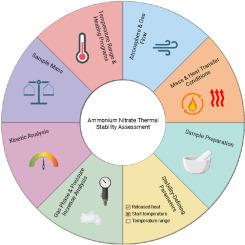Recommendations and guidelines for the safety evaluation of ammonium nitrate systems with the use of thermal analysis
IF 4.2
3区 工程技术
Q2 ENGINEERING, CHEMICAL
Journal of Loss Prevention in The Process Industries
Pub Date : 2025-07-11
DOI:10.1016/j.jlp.2025.105740
引用次数: 0
Abstract
Ammonium nitrate (AN) is a critical material widely used in fertilizers, propellants, and other industrial applications. Despite its importance, AN has been linked to numerous catastrophic incidents worldwide, underscoring the urgent need for rigorous and standardized safety evaluations. Its thermal decomposition behavior is highly sensitive to conditions such as temperature, pressure, impurities, and system configuration. However, inconsistent methodologies in thermal analysis have led to variable results and unreliable safety assessments, limiting their value for risk prediction and regulatory compliance.
This study presents a comprehensive set of experimental guidelines for evaluating the thermal stability of AN-based systems. Original data are combined with extensive literature analysis to address key methodological variables including sample mass, gas flow conditions, heating programs, and crucible geometry. Particular attention is given to how these factors influence the transition from endothermic dissociation to exothermic runaway, which is essential for identifying worst-case decomposition behavior.
The proposed framework supports accurate simulation of decomposition pathways under conditions relevant to storage, transport, and industrial processing. By bridging gaps in methodology, this work provides practical, safety-oriented guidance that improves the reproducibility and relevance of thermal analysis data. The findings contribute directly to hazard identification, process safety evaluations, and the safe design and handling of reactive AN systems. This study serves as a valuable reference for engineers, researchers, and regulators seeking to enhance thermal hazard assessments and prevent accidental initiation in ammonium nitrate applications.

使用热分析对硝酸铵系统进行安全评价的建议和指南
硝酸铵是广泛用于肥料、推进剂和其他工业用途的关键材料。尽管它很重要,但它与世界范围内的许多灾难性事件有关,强调了严格和标准化安全评估的迫切需要。它的热分解行为对温度、压力、杂质和系统配置等条件高度敏感。然而,热分析中不一致的方法导致了不同的结果和不可靠的安全评估,限制了它们在风险预测和法规遵从方面的价值。本研究提出了一套全面的实验准则,以评估基于人工智能系统的热稳定性。原始数据与广泛的文献分析相结合,以解决关键的方法变量,包括样品质量,气体流动条件,加热程序和坩埚几何形状。特别注意这些因素如何影响从吸热离解到放热失控的转变,这对于确定最坏情况下的分解行为是必不可少的。提出的框架支持在与储存、运输和工业加工相关的条件下精确模拟分解路径。通过弥合方法上的差距,这项工作提供了实用的、以安全为导向的指导,提高了热分析数据的可重复性和相关性。研究结果直接有助于危害识别、过程安全评估以及反应性AN系统的安全设计和处理。本研究为工程师、研究人员和监管机构寻求加强硝酸铵应用中的热危害评估和防止意外引发提供了有价值的参考。
本文章由计算机程序翻译,如有差异,请以英文原文为准。
求助全文
约1分钟内获得全文
求助全文
来源期刊
CiteScore
7.20
自引率
14.30%
发文量
226
审稿时长
52 days
期刊介绍:
The broad scope of the journal is process safety. Process safety is defined as the prevention and mitigation of process-related injuries and damage arising from process incidents involving fire, explosion and toxic release. Such undesired events occur in the process industries during the use, storage, manufacture, handling, and transportation of highly hazardous chemicals.

 求助内容:
求助内容: 应助结果提醒方式:
应助结果提醒方式:


